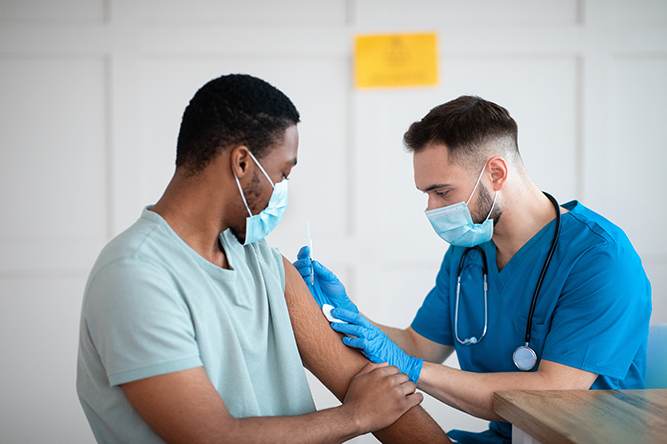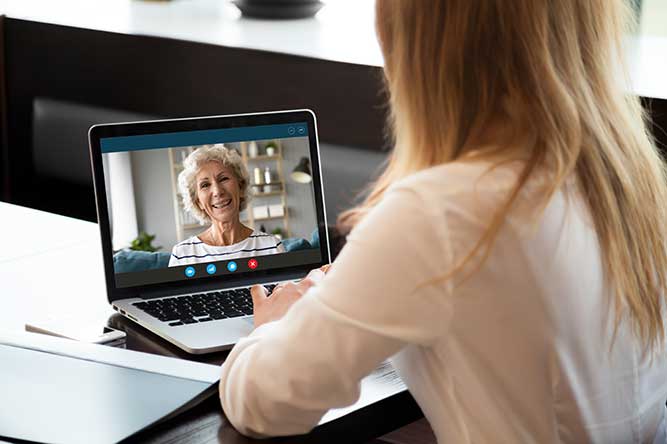
For most of us, the coronavirus pandemic quickly revealed the strengths and cracks in our senior care and living operations—and there was no area in which this was truer than in the area of communications. We have stand-up meetings for our team members. Our care communities have resident councils. We host family events. We must do a terrific job in communicating with our staff and those we serve—right?
The news media quickly identified the gaps and areas of weakness in our communications plans and efforts. Stories surfaced about senior care communities that hadn’t updated family members about the COVID-19 status of their loved ones or those of the building. The media found families to interview, and some of this feedback was quite humbling. In other cases, the interviews with families and residents felt unfair or inaccurate. We knew our health care heroes were working around the clock to prevent and manage a pandemic unlike any our world had seen in more than 100 years. Why didn’t the public and our stakeholders see this?
Interestingly, and usually, the family members who know our staff the best are our biggest advocates. Before non-essential visitors were restricted from our care communities, our families visited frequently. They came to know the staff who serve and care for their loved ones. They knew and trusted we were working for the best interest of the vulnerable and aging adults who we are honored to serve. But the pandemic changed this. Absence did not make the heart grow fonder, and instead, fear and a lack of trust permeated some in our profession. The federal and state governments quickly responded. No longer do we own the frequency and core content of our communication regarding COVID-19. We are now mandated in our communication efforts, and it is unlikely to change anytime soon.
COVID-19 Communication Lessons Learned
As part of the management services provided by Health Dimensions Group (HDG), we oversee and support the communications aspects of our 35 senior care and living communities. The communications needs and expectations of our managed communities are unique, and have increased in spades since the pandemic started. Keeping our staff, residents, families, referral sources, and the public updated with timely and relevant information has become an even more important part of our day-to-day operations. Through this work, we have learned a lot of lessons—some the hard way. The following is a list of lessons learned by our communications team during the COVID-19 pandemic.
Follow Your Organizational Values—Transparency Is Vital Regardless
Transparency is key to strong communications. Early on in the pandemic, our industry struggled with what and how much to communicate. Some in our profession chose to be less forthcoming in the number of cases and deaths that they were experiencing. HDG has five core values, three of which are integrity, hospitality, and respect. These company values have guided our decision making throughout the pandemic, which means that we are as transparent as we can be, while still complying with HIPAA and employment privacy policies.
Nursing homes and senior living communities are our residents’ personal homes and where our staff members spend the majority of their time outside of their own homes. Each of us see our colleagues and the residents and families we serve as members of our own extended families. Healthy families communicate. So even before our communication was mandated, we were committed to transparent communication, and we disclosed the number of positive cases and deaths among our beloved residents and staff. It’s always easy to deliver good news. It’s a lot harder to deliver bad news. Some of the senior communities that we manage are in very small towns which resulted not only in rumors within the care community, but also rumors in the greater community. In some cases, the news media heard about developments in the community before we could formally communicate with internal audiences.
We learned we can’t move fast enough. It’s important to deliver the current facts, but in some cases, it is also important to acknowledge a rumor and set the record straight. A strong leader has to keep their ears and hearts open. Address it head on and make sure everybody is clear as to the truth.
Consider Your Audience
The strongest communications and messages are tailored for the specific audience. One-size-fits-all is not the most effective way to share information with your audiences. Staff have a different mindset than the residents for whom they provide care and service. Providers and vendors have different needs for information. It’s important to tailor each message, while balancing available time, resources, and tools.
Elevate Communications as a Discipline
Historically, the discipline of communications has not always been as highly prioritized as that of sales and marketing. Throughout this public health crisis, the importance of communications with all audiences and stakeholders, such as families, staff, residents, discharged residents, referral sources, medical directors, board members, and vendors, has become even more important. In the past, we tended to think of internal stakeholders as supporting our sales and marketing efforts: We trained our staff on how to interface with sales prospects; and we appointed resident ambassadors to support our sales activities.
Today, in light of a pandemic, our internal stakeholders are now key to building our census and occupancy. Who is better equipped to reassure our prospects that life in a senior living and care community is enjoyable and safe—even during a pandemic? It is important that your staff, residents, families, medical director, and other audiences have a strong understanding of your COVID-19 response and action plan. Their confidence and testimonials regarding how your organization keeps them safe and engaged is essential information to marketing and selling your organization as a place to live and work.
Nothing Replaces the Use of Personal, One-to-One Communication
Nothing replaces human interaction and communication. Our communication with our residents, families, and staff is arguably one of the most important things we do as leaders and with each other. There is no substitution for the human voice. Calling family members personally, using digital technology such as Zoom or FaceTime to connect with loved ones, having stand-up meetings with staff, or visiting residents regularly (using appropriate personal protective equipment) are all important components to the communication plan. No flyer, app, website, email, or Facebook post—while all extremely important—can replace this personal communication. Corporate messaging and communication will never replace the importance of one-to-one communication. Our personal relationships are what make us fully human and allow us to build trust with one another.
Engage with Multiple Communication Methods and Tools
Using multiple methods of communication to reach different audiences is paramount. Most of us have strong preferences in the way that we receive and share information. I much prefer to pick up the phone or visit with someone in person. Some people respond best to text messages. We have families who only want us to communicate general updates through email. No one communication method is the best method. Recognizing this, HDG developed a multi-faceted communication plan and tool kit as outlined below.
Voice messaging scripts for residents, families, and staff. Voice messaging services allow providers to deliver comprehensive voice messages quickly and efficiently. In one of HDG’s large continuing care retirement communities, we can deliver more than 650 messages in a matter of minutes. Our managed communities use CallMultiplier and One Call Now, among others, and we are currently exploring an investment in industry-specific technology to support these efforts. We love using voice messaging because the human voice helps to build understanding and trust. It is also efficient. We develop customized scripts for staff, residents, and families, and the scripts themselves are great content to assist in talking points for staff stand-up meetings or conversations with residents.
Resident flyer. Some residents, particularly in the skilled nursing environment, do not have easy access to digital technology or websites. As a result, we distribute flyers to our residents regarding the COVID-19 status in the senior care community. That said, these flyers are secondary in importance to in-person communication. We feel it is especially important for caregivers or staff to provide reassurance in a time of anxiety and social isolation. A resident flyer assists with their talking points, as well as ensures the community meets the requirements of federal and state reporting and notification.
Email. While we all have too many emails in our inbox, this is still a preferred way for many to receive information. It also allows us to provide the level of detail necessary to fully meet the regulatory requirements in which we must share our COVID-19 response and action plan as well as any operational changes. Sending emails to our staff and families gives them comprehensive information and an ability to save our communications so they can return to the content should they have future questions.
Time clock. Posting important messages by or through the time clock or in the break room, while seemingly old-fashioned, can still be hugely effective. Figure out where people are congregating and communicating, and provide the information they seek. Remember to “meet them where they are.”
Virtual technology. Zoom, Skype, FaceTime, and GoToMeeting can be effectively used to connect families with their loved ones and staff. Even the most technology-adverse individuals and staff members have had to “up our game.” This technology has been a lifesaver during periods of social isolation.
Social media. The value of social media for connecting family members with their loved ones cannot be overestimated and could be the subject of a separate blog post. During a time in which loved ones are unable to visit care communities, social media is a window to everything that is going on in the lives of our residents. Photos of socially distanced staff, residents, and events allow stakeholders, referral sources, and prospective residents to get a glimpse of life at the care community.
Pay Attention to the Regulations
There has always been an intersection between the functions of communications, regulatory compliance, and policy. Suddenly, our communications efforts were not just the right thing to do—the frequency and content became mandated. As of May 29, 2020, Centers for Medicare & Medicaid Services (CMS) memorandum QSO 20-29 required that nursing homes provide notification to residents and their representatives of positive and suspected COVID-19 cases among residents and staff by 5:00 p.m. the next calendar day. In some states, such as California and Indiana, daily or almost daily communication is required.
Our organization felt that all our managed senior living communities—whether they be assisted living, memory care, or independent living—should also follow these regulations. Our philosophy is to communicate, communicate, and communicate. There is benefit to redundancy, especially in a pandemic when so many of us are distracted and potentially anxious and worried.
Stay Close to Operations
HDG established a COVID-19 leadership group that met daily during the early stages of the pandemic. We continue to meet weekly or more often as essential issues evolve. As communications professionals, it is our job to listen closely to identify messages and content that is important to communicate to staff, residents, families, board members, referral sources, and other relevant stakeholders. Did the Centers for Disease Control and Prevention update the COVID-19 symptoms? Did the return-to-work criteria change? Is the community moving to Phase 1 reopening with outdoor visits? Regulation and operational changes happen daily, and the relevant information must be shared as soon as possible with key stakeholders.
Learn from Others’ Expertise
The senior care and living industry is blessed with having strong professional associations, which recognized early in the pandemic that member organizations needed key messaging, templates, and resources to support our communication. Since HDG is based in Minneapolis, Minnesota, and due to our long-term relationship with LeadingAge Minnesota, their local communications and policy teams have been terrific sources for new and evolving information. The American Health Care Association and their state-level affiliates, as well as Argentum, have also done an extraordinary job in supporting communications professionals across the country. Each of these organizations and their advice helped make us stronger.
I also rely heavily on the insight of my talented marketing and communications team, along with other senior living marketing and communications professionals, to help brainstorm solutions to communications challenges. If you haven’t “phoned a friend,” I strongly encourage you to do so. There is so much value in collective wisdom.
Be Open to Feedback and Continuous Quality Improvement
As a communications team, we continue to learn something nearly every day that improves the quality of our work. Early on in the pandemic, one of the communities in our portfolio required the deployment of our rapid response team. This team was led by one of our operations and consulting executives who went on site and helped guide the management team and provide additional leadership and support. One day, he called me and said that we needed to improve the creativity of our messaging. He fully understood that some content can and must be more of a template; however, without more unique and personal messaging, he felt like “an auctioneer.” This was helpful feedback, and we especially loved the candor.
Interviews with our executive directors and other staff revealed that we could be more positive and warm—even in the face of a pandemic. We seek direct feedback from family members and will be refining our family and resident satisfaction surveys so we can continue to get input to improve our communications efforts. This feedback makes us stronger.
In Summary
Effective communications will continue to be an essential component of your COVID-19 surveillance plan. Gone are the days when communications could be a secondary consideration. Each and every day, you should ask yourself and your leadership team to identify the key messages that must be shared with your internal audiences, partners, and the public. Through an intentional and well-thought-out communication plan, you will be well on your way to earning the trust of those individuals you currently serve and those you aim to serve.
HDG can support your organization by providing full-service management services. For additional information, see our website or contact our team at info@hdgi1.com or 763.537.5700.









